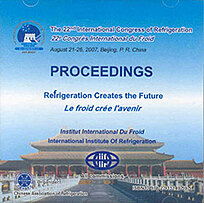
Document IIF
Une introduction au froid magnétique.
An introduction to magnetic refrigeration.
Auteurs : EGOLF P. W., KITANOVSKI A., VUARNOZI D., et al.
Résumé
At present, a great amount of research work is being performed to develop new magnetocaloric materials, which are the refrigerants of magnetic refrigerators. This leads to continuous development of increasingly high-performance magnetic refrigerants with higher entropy differences, higher adiabatic temperature differences and lower hysteresis effects. Also, increased activity to design better thermomagnetic refrigerators is occurring and numerous promising patents on machines with magnetocaloric porous beds have been filed. In a new IIR Working Party on magnetic refrigeration, the different activity groups have set up close relations, leading to welcome interactions between material scientists, physicists working on magnetism and specialists in fluid dynamics and thermodynamic machine design. All these expanding activities lead to a very high potential for magnetic refrigerators and for market penetration, which most probably at will first occur in some niche markets. After that, for some main sales domains of refrigeration - e.g. as for classic commercial refrigerators - an entrance to the market also seems feasible. Other markets are in air conditioning, heat-pump applications, process technology, the automobile industry, medical domains, etc.
Documents disponibles
Format PDF
Pages : ICR07-B1-1612
Disponible
Prix public
20 €
Prix membre*
Gratuit
* meilleur tarif applicable selon le type d'adhésion (voir le détail des avantages des adhésions individuelles et collectives)
Détails
- Titre original : An introduction to magnetic refrigeration.
- Identifiant de la fiche : 2007-2098
- Langues : Anglais
- Sujet : Technologie
- Source : ICR 2007. Refrigeration Creates the Future. Proceedings of the 22nd IIR International Congress of Refrigeration.
- Date d'édition : 21/08/2007
Liens
Voir d'autres communications du même compte rendu (839)
Voir le compte rendu de la conférence
Indexation
-
Thèmes :
Froid calorique (froid magnétocalorique, électrocalorique, élastocalorique et barocalorique);
Autres systèmes de production de froid (dessiccation, thermoélectricité, thermoacoustique...) - Mots-clés : Technologie; Calcul; Réfrigerateur magnétique; Magnétisme; Historique; Cycle thermodynamique; COP
-
Overview of magnetic refrigeration.
- Auteurs : WILSON N., OZCAN S., SANDEMAN K., et al.
- Date : 2006
- Langues : Anglais
Voir la fiche
-
An introduction to magnetic refrigeration.
- Auteurs : EGOLF P. W., KITANOVSKI A., VUARNOZ D., et al.
- Date : 08/06/2007
- Langues : Anglais
- Source : Technological innovations in air-conditioning and refrigeration industry + CD-ROM.
Voir la fiche
-
Research on performance of regenerative room te...
- Auteurs : YU B., GAO Q., YANG D., et al.
- Date : 27/09/2005
- Langues : Anglais
- Source : 1st International Conference on Magnetic Refrigeration at Room Temperature
- Formats : PDF
Voir la fiche
-
A magnetic field source system for magnetic ref...
- Auteurs : ALLAB F., KEDOUS-LEBOUC A., YONNET J. P., et al.
- Date : 27/09/2005
- Langues : Anglais
- Source : 1st International Conference on Magnetic Refrigeration at Room Temperature
- Formats : PDF
Voir la fiche
-
Performance metrics for active magnetic refrige...
- Auteurs : ROWE A.
- Date : 11/05/2009
- Langues : Anglais
- Source : 3rd International Conference on Magnetic Refrigeration at Room Temperature
- Formats : PDF
Voir la fiche
